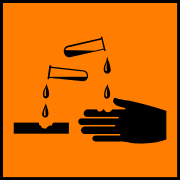Standard level
Acids react in a characteristic manner with several types of reagent.
Syllabus ref: R3.1.3Reactivity 3.1.3 - Some species can act as both Brønsted–Lowry acids and bases.
- Interpret and formulate equations to show acid–base reactions of these species.
Guidance
Tools and links
- Structure 3.1 - What is the periodic trend in the acid–base properties of metal and non-metal oxides?
- Structure 3.1 - Why does the release of oxides of nitrogen and sulfur into the atmosphere cause acid rain?

Amphoteric behaviour
An amphoteric substance can neutralise both acids and bases. Such substances are exemplified by oxides of 'poor' metals, i.e. metals from the centre of the periodic table, such as aluminium oxide and zinc oxide.
Example: The reaction of aluminium oxide and sodium hydroxide:
Al2O3 + 2NaOH → 2NaAlO2 + H2O
Aluminium oxide + sodium hydroxide → sodium aluminate + water
Example: The reaction of aluminium oxide and sulfuric acid
2Al2O3 + 3H2SO4 → 2Al2(SO4)3 + 3H2O
aluminium oxide + sulfuric acid → aluminium sulfate + water
Amphiprotic species
An amphiprotic compound can act as both a Bronsted-Lowry acid and a Bronsted=Lowry base, it can both donate and accept protons in chemical reactions.
Hydrogencarbonate ions, HCO3- are amphiprotic:
hydrogencarbonate ions accepting a proton
HCO3- + H+ → H2CO3
hydrogencarbonate ions donating a proton
HCO3- → CO32- + H+
Note: Students are no longer expected to differentiate between the terms "amphiprotic" and "amphoteric".